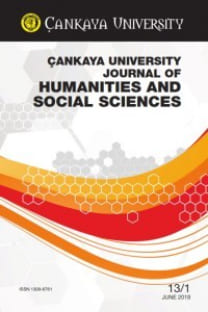Prejudice against Homosexuality and Locus of Control
Bu çalıflmanın amacı eflcinselli¤e iliflkin önyargılı tutumlar ile içsel-dıflsal kontrol oda¤ı, cinsiyet far- kı ve sosyal temas arasındaki iliflkiyi arafltırmaktır. Türkiye’deki çeflitli üniversitelerden 198 ö¤renci bu ça- lıflmaya katılmıfltır. Katılımcıların yafl ortalaması 21.14 (SS = 2.38) de¤erindedir. Katılımcılar Hudson ve Ricketts’ın 25 maddelik Eflcinselli¤e iliflkin Tutumlar Ölçe¤i, ‹ç-dıfl Kontrol Oda¤ı Ölçe¤i ve cinsiyet, sos- yal temas ve yaflı içeren demografik bilgi fromunu doldurmufllardır. Eflcinselli¤e iliflkin önyargılı tutumlar sadece dıfl kontrol oda¤ının kadere inanç, çabanın anlamsızlı¤ı ve flansa inanç alt faktörleri ile korelayon göstermifltir. ANOVA sonucuna göre, dıfl kontrol oda¤ı, cinsiyet farkı ve sosyal temas ana etkileri istatis- tiksel olarak anlamlı bulunmufltur. Ancak, bu de¤iflkenler arası etkileflim bulunamamıfltır. Ayrıca, yapılan regresyon analizi sonucuna göre eflcinselli¤e iliflkin önyargıyı kader inanç alt unsuru anlamlı bir flekilde yordamıfltır
Anahtar Kelimeler:
ANAHTAR KEL‹MELEReflcinsellik, önyargı, iç-dıfl kontrol oda¤ı, sosyal temas ve cinsiyet farkları
Prejudice against Homosexuality and Locus of Control
The purpose of the study was to explore the relationship between prejudice against homosexuality,internal-external locus of control, sex differences and social contact. A total of 198 university studentsfrom various Turkish universities participated in this study. The mean age of the participants was 21.14(SD = 2.38). The participants filled Hudson and Ricketts’ 25-item Attitudes toward Homosexuality Scale,Internal-External Locus of Control Scale, and demographic variables including sex differences, socialcontact and age. The prejudice against homosexuality were only correlated with the sub-factors of externallocus of control namely belief in fate, meaninglessness of effortfulness, and belief in chance. The performedANOVA presented that the main effects of the level of external locus of control, sex differences, and socialcontact were only statistically significant, but there were no interactions between them. Regression analysisshowed that belief in fate was the only significant predictor of the prejudice against homosexuality
Keywords:
homosexuality prejudice, internal-external locus of control, social contact, and sex differences,
___
- Aguero, J. E., L. Bloch, and D. Byrne. “The Relationships Among Sexual Beliefs, Attitudes, Experience and Homophobia,” Journal of Homosexuality, 10 (1984), pp.95-107.
- Akrami, N., B. Ekehammar, and T. Araya. “Classical and Modern Racial Prejudice: A Study of Attitudes toward Immigrants in Sweden,” European Journal of Social Psychology, 30 (2000), pp.521–532.
- Crandall, C. S., S D’Anello, N. Sakall›, E. Lazarus, G. W. Nejtardt, N. T. Feather. Attribution-value Model of Prejudice: Anti-fat Attitudes in Six Nations,” Personality and Social Psychology Bulletin, 27 (2001), pp.30-37.
- Ç›rako¤lu, O. C. “Perception of Homosexuality Among Turkish University Students: The Role of Labels, Sex Differences and Prior Contact,” The Journal of Social Psychology, 146/3 (2006), pp.293-305.
- Da¤, I. “Rotter’in ‹ç-D›fl Kontrol Oda¤› Ölçe¤i’nin Üniversite Ö¤rencileri ‹çin Güvenirli¤i ve Geçerli¤i (Validitiy and Reliability of Rotter’s Internal-External Locus of Control Scale with Turkish University Students),” Psikoloji Dergisi (Turkish Journal of Psychology), 7 (1991), pp.10-16.
- Da¤, I. “Kontrol Oda¤›, Ö¤renilmifl Güçlülük ve Psikopatoloji ‹liflkileri (The Relations Among Locus of Control, Learned Resourcefulness and Psychopathology),” Türk Psikoloji Dergisi (Turkish Journal of Psychology), 7 (1992), pp.1-9.
- Da¤, I. “The Relationship among Paranormal Beliefs, Locus of Control and Psychopathology in a Turkish College Students,” Personality and Individual Differences, 26 (1999), pp.723-737.
- Da¤, I. “Kontrol Oda¤› Ölçe¤i (KOÖ): Ölçek Gelifltirme, Güvenirlik ve Geçerlik Çal›flmas› (Locus of Control Scale: Scale Development, Reliability and Validity Study),” Türk Psikoloji Dergisi (Turkish Journal of Psyhcology), 17/49, (2002), pp.77-92.
- Duyan, V., and G. Duyan. “Turkish Social Work Students’ Attitudes Toward Sexuality,” Sex Roles, 52/9,10 (2005), pp.697-706.
- Ellis, A. L. and R. B. Vasseur. “Prior interpersonal contact with and attitudes towards gays and lesbians in an interviewing context,” Journal of Homosexuality, 25/4 (1993), pp.31-45.
- Ficarrotto, T. J. “Racism, Sexism, and Erotophobia: Attitudes of Heterosexuals Toward Homosexuals,” Journal of Homosexuality, 19/1, (1990), pp.111-116.
- Glick, P., and T. S. P. Fiske. “The Ambivalent Sexism Inventory: Differentiating Hostile and Benevolent Sexism,” Journal of Personality and Social Psychology, 70 (1996), pp.491-512.
- Haddock, G., M. P. Zanna, and V. M. Esses. “Assessing the structure of prejudicial attitudes: The case of attitudes toward homosexuals,” Journal of Personality and Social Psychology, 65/6 (1993), pp.1105-1118. Heaven, P. C. L. and L. N. Oxman. “Oxman, Human Values, Conservatism and Stereotypes of Somosexuals,” Personality and Individual Differences, 27/1, (1999), pp.109-118.
- Herek, G. M. “Religious Orientation and Prejudice: A Comparison of Racial and Sexual Attitudes,” Personality & Social Psychology Bulletin, 13/1 (1987), pp.34-44.
- Herek, G. M., and J. P. Capitanio. “‘Some of My Best Friends...:’ Intergroup Contact, Concealable Stigma and Heterosexuals’ Attitudes Toward Lesbians and Gay Men,” Personality and Social Psychology Bulletin, 22, (1996), pp.412-424.
- Hudson, W. W., and W. A. Ricketts. “Ricketts, Strategy for the Measurement of Homophobia,” Journal of Homosexuality, 5 (1980), pp.357-372.
- Kite, M. E., and B. E. Whitley. “Sex Differences in Attitudes toward Homosexual Persons, Behaviour, and Civil Rights: A Meta-Analysis,” Personality and Social Psychology Bulletin, 22 (1996), pp.336-353. Klein, O., M. Snyder, and R. W. Livingston. “Livingston, Prejudice on the Stage: Self-monitoring and the Public Expression of Group Attitudes,” British Journal of Social Psychology, 4 (2004), pp.299-314. Lance, L. M. “The Effects Of Interaction with Agy Persons on Attitudes toward Homosexuality,” Human Relations, 40/6 (1987), pp.329-336.
- Quadrel, M. J. and R. R. Lau. “Health Promotion, Health Locus of Control and Health Behavior: Two Field Studies,” Journal of Applied Social Psychology, 19 (1989), pp.1497-1521.
- Parrott, D. J., H. E. Adams, and A. Zeichner. “Homophobia: Personality and Attitudinal Correlates,” Personality and Individual Differences, 32 (2002), pp.1269-1278.
- ISSN: 1309-6761
- Yayın Aralığı: Yılda 2 Sayı
- Başlangıç: 2004
- Yayıncı: Çankaya Üniversitesi
Sayıdaki Diğer Makaleler
Ada Holly Shissler, Between Two Empires: Ahmet Agaoglu and the New Turkey
The Makers of the Modern Middle East (London: Haus Books, 2011)
Hakan M. Yavuz, Islamic Political Identity in Turkey
Duygusal Emekte Baz Demografik Değişkenlerin Rolü: Görgül Bir Araştırma
Memduh BEĞENİRBAŞ, H. Nejat BASIM, Editörden
Prejudice against Homosexuality and Locus of Control
Mehmet Akıncı, Türk Muhafazakârlarığı: Çok Partili Siyasal Hayattan 12 Eylüle
Resistance as the Discourse of Docile Bodies in Plath\'s The Bell Jar
